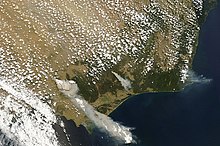| Black Saturday Bushfires | |
|---|---|
 MODIS Aqua satellite image of smoke plumes and a pyrocumulus cloud northeast of Melbourne during the morning of 7 February 2009. | |
| Date(s) | 7 February – 14 March 2009 |
| Location | Victoria, Australia |
| Statistics | |
| Burned area | 450,000 hectares (1,100,000 acres)[1] |
| Land use | Urban/Rural Fringe Areas, Farmland, and Forest Reserves/National Parks |
| Impacts | |
| Deaths | 173[2][3][4] |
| Non-fatal injuries | 414[5] |
| Structures destroyed | 3,500+ (2,029 houses) |
| Ignition | |
| Cause | Various confirmed sources including: |
The Black Saturday bushfires were a series of bushfires that either ignited or were already burning across the Australian state of Victoria on and around Saturday, 7 February 2009, and were one of Australia's all-time worst bushfire disasters. The fires occurred during extreme bushfire weather conditions and resulted in Australia's highest-ever loss of human life from a bushfire,[10] with 173 fatalities.[11] Many people were left homeless and family-less as a result.
As many as 400 individual fires were recorded on Saturday 7 February; the day has become widely referred to in Australia as Black Saturday.
Deputy Prime Minister Julia Gillard described Black Saturday as "a tragedy beyond belief, beyond precedent and beyond words … one of the darkest days in Australia’s peacetime history."[12]
The 2009 Victorian Bushfires Royal Commission, headed by Justice Bernard Teague, was held in response to the bushfires.
- ^ Collins, Pádraig (12 February 2009). "Rudd criticised over bush fire compensation". Irish Times. Ireland. Archived from the original on 9 October 2012. Retrieved 19 February 2009.
- ^ "About Black Saturday - Country Fire Authority". 27 September 2019. Archived from the original on 27 September 2019. Retrieved 31 December 2019.
- ^ "What has Australia learned from Black Saturday?". 16 April 2019. Archived from the original on 16 April 2019. Retrieved 31 December 2019.
- ^ "2009 Victorian Bushfires". 20 May 2019. Archived from the original on 20 May 2019. Retrieved 31 December 2019.
- ^ Cite error: The named reference
Australian Medical Journalwas invoked but never defined (see the help page). - ^ Cite error: The named reference
VBRC-Vol.01-ch.5-p.075was invoked but never defined (see the help page). - ^ Rennie, Reko (1 April 2009). "Marysville fire deliberately lit: police". The Age. Melbourne: Fairfax Media. Archived from the original on 7 September 2017. Retrieved 5 June 2010.
- ^ "Lightning starts new bushfires in Grampians". ABC News. 8 February 2009. Archived from the original on 7 August 2020. Retrieved 9 February 2009.
- ^ "Police track arsonists responsible for Victoria bushfires". News Limited. The Australian. 10 February 2009. Archived from the original on 13 February 2009. Retrieved 14 February 2009.
- ^ Huxley, John (11 February 2009). "Horrific, but not the worst we've suffered". The Sydney Morning Herald. Fairfax Media. Archived from the original on 13 February 2009. Retrieved 16 July 2020.
- ^ 2009 Victorian Bushfires Royal Commission - Final Report (PDF) (Report). Government Printer for the State of Victoria. July 2010. Archived (PDF) from the original on 27 February 2019. Retrieved 16 July 2020.
- ^ "Black Saturday bushfires". Lawson Crescent Acton Peninsula, Canberra: National Museum of Australia. 7 February 2023. Archived from the original on 6 January 2020. Retrieved 10 April 2024.
Deputy Prime Minister Julia Gillard, 2009: A tragedy beyond belief, beyond precedent and beyond words … one of the darkest days in Australia's peacetime history.